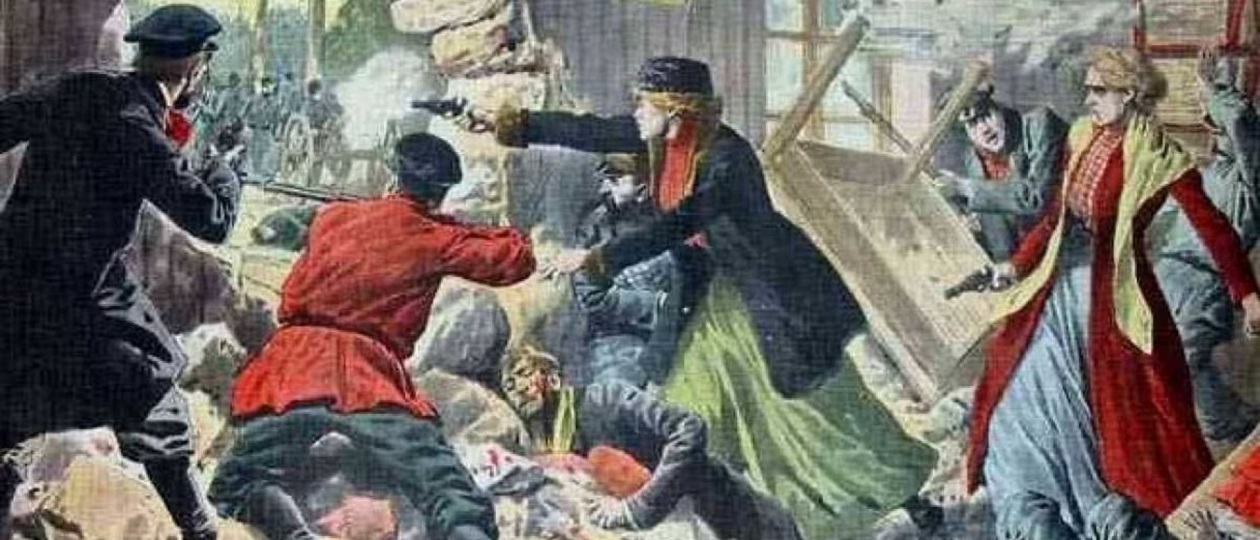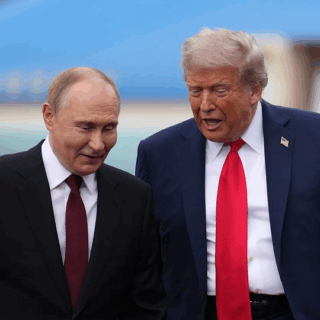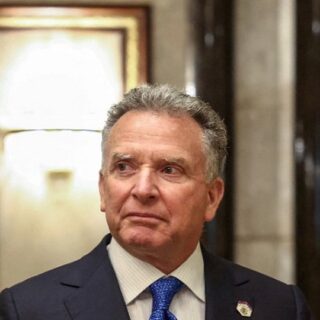
Terrorism in the Russian Empire between 1901-1911 was both a multiethnic and multireligious phenomenon. In no way can it be considered an ethnically Russian phenomenon.
However, too many historians ignore the multiethnic and multireligious composition of terrorists in Russia, and this is one more reason why terrorism remains a Great Unknown.
Part of the problem in assessing the multi-ethnic nature of terrorism in Russia involves words. There are two words for Russian in the Russian language. “Russkii- русский” refers to ethnic Russian. The word “rossiiskii—российский” refers to Russian in the sense of belonging to the Russian Empire. That is why I use the expression “Российская революция” to refer to the Russian revolutions of 1905-1907 and 1917-1922 because these revolutions took place in an empire.
The Russian Empire was the most multiethnic country in Europe. Using data from the First All-Russian Census of the Population of 1897, German historian Andreas Kappeler estimated that ethnic Russians made up 44.3% of the 125,640,000 inhabitants of Russia. Russians, Belarusians, and Ukrainians—Eastern Slavs—made up 66.8%. [1, p. 397]. Note that members of the government and many political movements did not consider Ukrainians and Belarusians separate peoples, but rather merely as branches of a larger Russian people.
There were four major groupings of political parties and movements participating in terrorism between 1901-1911.
- Empire-wide (общеимперские) socialist parties: the Socialists-Revolutionaries (SRs) who considered themselves the heirs of the People’s Will; the Union of Socialists-Revolutionaries-Maximalists who split from the SR party over the leadership’s decision to suspend terrorism; Social Democrats—both Bolsheviks and Mensheviks. Many members of the ethnic minorities belonged to these parties.
- Anarchist groups and movements of Anarcho-Communists, Anarcho-Syndicalists, and Anarcho-Individualists. Anarchists considered terrorism <<propaganda by the deed>>. Even anarchists opposing terrorism could justify it by describing it as a spontaneous act by the common people. Outside the camp of the socialist parties and anarchists many marginal leftist groups with no party affiliation practiced terrorism. Members of these groups had often quit parties and even anarchist groups because they objected to any restrictions on practicing terrorism. Many members of ethnic minorities participated in these movements.
- National minority (or national/национальные) Marxist Social Democratic and Populist [Народнические] parties, especially Polish, Jewish, Armenian, and Latvian parties. Many of these parties were affiliated with the empire-wide leftist parties. The major exception among the national minority parties was the right-wing Polish National Worker’s Union under the leadership of the National Democratic Party. Union members not only attacked Russian officials, but also Polish workers on strike and socialists.
- Black Hundred [черносотенные] fighting squads from the Union of the Russian People and other extreme-right organizations. They killed several liberal Duma deputies. Black Hundred terrorism marked the beginning of right-wing terrorism in Europe in the 20th [2, cc. 220-221]. Despite its Russian nationalism, the Union of the Russian People had members from different nationalities so its terrorism could take on multiethnic dimensions.
Members of the non-Russian minorities had different reasons for joining empire-wide revolutionary and oppositional (liberal) parties. Some were indifferent or even hostile to the demands of national minority parties for autonomy or independence. In fact, some had become so Russified that they broke all connections with their ethnic backgrounds. Others believed that significant change could only come only if all antigovernment elements united in overthrowing the government and did not want to see a revolution fail because it shattered along ethnic lines. Many non-Russian revolutionaries and oppositionists, especially Jews, believed that all ethnic and religious discrimination would end once the government was overthrown.
In some cases, membership of non-Russians in some empire-wide parties and movements happened almost by default. Many anarchist groups operated in the western and southern provinces where Jews made up a large proportion of the population, and, consequently, often were the majority in anarchist organizations.
Relationships between empire-wide and national minority parties could be tense. The left-wing parties, such as the SR and Social Democrats, often suspected that the national parties only paid lip service to socialism and they were more nationalists than socialists. Members of the national parties could doubt the commitment of Russian leftists to equality for all nationalities and suspected that they too could be Russian nationalists. However, division between all empire-wide, national minority and anarchist parties and movements were not rigid and members of all types of leftist movements–both empire-wide and national minority– often conducted joint terrorist attacks.
National minority parties made up a large proportion of the approximately 300 political parties that existed in the Russian Empire between 1882 and 1925. Russian historian V. V. Kriven’kii gave the following statistics: before 1905, there were 4 empire-wide and 47 national parties; 45 empire-wide and 113 national parties by February 1917. Between February and October 1917, another 8 empire-wide and 46 national parties formed; between 1917-1925, yet another 7 empire-wide and 76-79 national parties formed. Krivenkii gives the total number of parties from 1882-1925 as 60 empire-wide and 228-231 ethnic minority parties. [3, cc. 123-130] Parties of the ethnic minorities, especially of Poles, Jews, Armenians, Latvians, Finns, and others, often were formed before empire-wide parties, thanks partly to higher levels of political consciousness among inhabitants of the border regions. Somewhat ironically, many ethnic minority parties formed long before Russian nationalist parties such as the Union of the Russian People.
Selectiveness on the part of some historians keeps the ethnic dimensions of terrorism in Russia a Great Unknown. Russian historian O. V. Budnitskii restricted his coverage of revolutionary terrorism to the Empire-wide socialist parties and movements and to the anarchists of different tendencies because socialists and anarchists wanted a sweeping social revolution. He excluded the terrorism of the ethnic minority parties from the category of revolutionary terrorism because <<this is another type of terrorism; it has different ideological, political, and psychological roots. Therefore, it is difficult to relate this to the Russian (русскому) revolutionary movement. [4, cc. 15-16]
There is absolutely no reason to exclude the terrorism of the ethnic minority parties from the general category of revolutionary terrorism. The national parties wanted autonomy or independence. These demands were revolutionary because they sought a major restructuring of Russia and would have put an end to the centralized empire. The problem was that while the liberals and socialists of the empire-wide parties favored decentralization of the country, many were not willing to support the breakup of the empire along ethnic lines. This of course fueled charges from non-Russians that Russian liberals and socialists were as nationalistic as the conservatives and reactionaries.
The fact remains that terrorism of the national parties became part of the massive terrorism presence in Russia between 1901-1911. However, ethnic minority terrorism had its peculiarities. This type of terrorism was strongest in Poland, Ukraine, Belarus, Moldova, the Baltic region, and Caucasus where social, ethnic, and religious factors often intersected. Mass violent protest movements were strong in these regions because of the intersection of social, ethnic, and religious factors, and terrorist acts could intersect with mass protest movements.
In their own way, ethnic minority terrorists conducted a terrorist campaign on several fronts simultaneously. They often killed Russians and people of other nationalities from the bureaucracy, police, army, Orthodox clergy, nobility and propertied classes. They also killed members of their own nationalities whom they either suspected of treason to the national cause or because they considered them class enemies.
This terrorist war on several fronts combined elements of civil war, especially in the borderlands, not often between people of different ethnic groups and religions, but also among members of different ethnic groups and religions.
In the Caucasus, terrorists of all nationalities adapted their tactics to local traditions of violence. They used blood feuds and vendettas, kidnapping women and children, demanding ransoms, burning crops, forbidding harvest operations. [5, p. 25]. Members of the Caucasus All-Muslim Union, formed in 1906, urged its members to kill anybody spreading both “Armenian influences and Russification policies of the government.” [5, p. 25]. Armenians were singled out for assassination because they formed a large part of the business and professional classes in the region. Any official, soldier, schoolteacher, Orthodox priest or Russian-speaker could be considered an agent of Russification.
Latvian terrorists conducted a terrorist war on several fronts. They killed German landowners, estates stewards, Russian Orthodox priests, German Lutheran pastors, township elders and their assistants as well as teachers and clerks who did not support their demands. Much the same range of victims was killed in Estonia. [5, pp. 30-31]
Ethnic minority terrorism was capable of ripping apart ethnic and religious communities. The involvement of many young Jews in terrorist and other revolutionary activities undoubtedly left their traditionalist elders and coreligionists terrified that they would be the victims of pogroms because reactionaries could always blame the Jews as revolutionary troublemakers.
In a certain way, ethnic minority was a derivative of the government’s policies of Russification, especially in universities, other post-secondary institutions, and secondary schools. Non-Russians in these schools could easily acquaint themselves with the latest revolutionary ideologies and tactics and apply them to their own national movements. Certainly, the apparent successes of the empire-wide parties in using terrorism as a means of political struggle encouraged many national populist and Marxist parties to try this tactic.
We still do not know entirely why ethnic minority terrorism forms such a Great Unknown in the history of terrorism in the Russian Empire. Confusing terminology about the word Russian explains part of it. Also, some historians simply confine the history of terrorism to the empire-wide parties and movements.
I suggest that possibly historians writing about the ethnic minorities sense a certain embarrassment that members of these minorities not only engaged in left-wing terrorism, but also worked closely with Russian left-wing terrorists. History can be rewritten to suit any ideology and nationalism is no exception.
Let’s look at other factors that keep terrorism in Russia a Great Unknown.
Sources Used
- Kappeler, Andreas. The Russian Empire: a multiethnic history. Trans. Alfred Clayton. Harlow UK: Pearson Education, 2001. Доступен в русском переводе. Каппелер А. Россия–многонациональная империя. Перевод с немецкого. Москва: “Традиция”; “Прогресс-Традиция”, 2000.
- Рокки, Энтони Карл. Периодизация истории политического терроризма в Российской империи между 1866-1911: элементы преемственности и перемен (Periodization of the history of political terrorism in the Russian Empire between 1861-1911: elements of continuity and change). Гусевские чтения–2023. Три измерения политической истории России: идеология, политика, практика. Москва: ИКД «Зерцало-М»; МГПУ, 2023, сс. 108-124.
- Кривенький В. В. Новые данные сравнительно-количественного анализа политических партий России (New data of comparative quantitative analysis of political parties in Russia)// История национальных политических партий России The history of national political parties of Russia): материалы Междунар. конф. (materials of an international conference) (Москва, 21–22 мая 1996 г.) / отв. ред. В. В. Шелохаев. Москва.: РОССПЭН, 1997. С. 123–130.
- Будницкий О.В. Терроризм в российском освободительном движении: идеология, этика, психология (вторая половина XIX – начало XX в.). (Terrorism in the Russian liberation movement: ideology, ethics, psychology (second half of the 19th century—start of the 20th century). 2-е издание, дополненное. Москва: «Российская политическая энциклопедия» (РОССПЭН), 2016.
- Geifman, Anna. Thou shalt kill: revolutionary terrorism in Russia, 1894-1917. Princeton NJ: Princeton University Press, 1993. Русский перевод в электронной форме. Гейфман, Анна. Революционный террор в России, 1894— 1917. Москва: КРОН-ПРЕСС, 1997. https://royallib.com/book/geyfman_anna/revolyutsionniy_terror_v_rossiihtml





